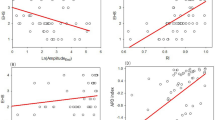Abstract
The aim of this study was to look into a molecule in penile blood sample that shows correlation with the tumescence grade and/or penile Doppler ultrasound findings. Patients admitted to urology outpatient clinic with the complaint of erectile dysfunction between November 2006 and April 2007 were evaluated. Patients with the history of phosphodiesterase inhibitor usage or genital trauma, genital abnormalities, Peyronie's disease, endocrinopathies, cardiovascular diseases and major psychiatric or neurological disorders were excluded. Those patients were later evaluated with a penile Doppler ultrasound, 10–20 min after intracavernosal injection of 60 mg of papaverine hydrochloride. Tumescence grade, peak-systolic velocity (PSV), end-diastolic velocity (EDV) and resistive index (RI) were recorded. Blood samples were drawn from penis and the levels of calcium, myeloperoxidase, malondialdehyde, nitrite, nitrate, vasoactive intestinal peptide and cyclic guanosin monophosphate (cGMP) and the activity of superoxide dismutase were measured. A total of 46 patients with erectile dysfunction were included. The median age of the patients was 49.3±10.2 (range 24–67). We could not find any significant correlation between penile Doppler ultrasound parameters and any of penile blood measurements except cGMP that demonstrated a significant negative correlation with PSV (ρ=−0.533, P=0.001) and RI (ρ=−0.468, P=0.005). However, a positive correlation between cGMP and EDV was detected (ρ=0.322, P=0.059). Mean cGMP levels were 3.347±0.694 pmol ml−1 (2.295–4.685), 3.193±0.669 pmol ml−1 (2.165–4.094) and 2.742±0.690 pmol ml−1 (1.290–4.011) in grades 2, 3 and 4 tumescence groups, respectively, and the difference among mean cGMP levels of these groups were statistically significant (P=0.027). As a conclusion, penile blood cGMP level showed a significant negative correlation with mean PSV, RI values and tumescence grade, whereas there was a positive but insignificant correlation between cGMP and mean EDV value.
This is a preview of subscription content, access via your institution
Access options
Subscribe to this journal
Receive 8 print issues and online access
$259.00 per year
only $32.38 per issue
Buy this article
- Purchase on Springer Link
- Instant access to full article PDF
Prices may be subject to local taxes which are calculated during checkout




Similar content being viewed by others
References
Siroky MB, Azadzoi KM . Vasculogenic erectile dysfunction: newer therapeutic strategies. J Urol 2003; 170 (2 Part 2): 24–29.
Lue TF, Broderick GA . Evaluation and nonsurgical management of erectile dysfunction and premature ejaculation. In: Wein AJ, Kavoussi LR, Novick AC, Partin AW, Peters CA (eds). Campbell-Walsh Urology, 9th edn, vol. 2, Chapter 22 Saunders Elsevier: Philadelphia, 2007.
Kassouf W, Carrier S . A comparison of the international index of erectile function and erectile dysfunction studies. BJU Int 2003; 91: 667–669.
Ghanem H, Shamloul R . An evidence-based perspective to commonly performed erectile dysfunction investigations. J Sex Med 2007; 5: 1582–1589.
Glowick SP, Kaplan SD . Methods in Enzymology, vol. 2 Academic Press: New York, 1955, pp 769–782.
Sun Y, Oberley LW, Li Y . A simple method for clinical assay of superoxide dismutase. Clin Chem 1988; 34: 497–500.
Yoshioka T, Kawada K, Shimada T, Mori M . Lipid peroxidation in maternal and cord blood and protective mechanism against activated-oxygen toxicity in the blood. Am J Obstet Gynecol 1979; 135: 372–376.
Miranda KM, Espey MG, Wink DA . A rapid, simple spectrophotometric method for simultaneous detection of nitrate and nitrite. Nitric Oxide 2001; 5: 62–71.
Serefoglu EC, Atmaca AF, Dogan B, Altinova S, Akbulut Z, Balbay MD . Problems in understanding the Turkish translation of the international index of erectile function. J Androl 2008; 29: 369–373.
Breza J, Aboseif SR, Orvis BR, Lue TF, Tanagho EA . Detailed anatomy of penile neurovascular structures: surgical significance. J Urol 1989; 141: 437–443.
Jarow JP, Pugh VW, Routh WD, Dyer RB . Comparison of penile duplex ultrasonography to pudendal arteriography. Variant penile arterial anatomy affects interpretation of duplex ultrasonography. Invest Radiol 1993; 28: 806–810.
Burnett AL, Lowenstein CJ, Bredt DS, Chang TS, Snyder SH . Nitric oxide: a physiologic mediator of penile erection. Science 1992; 257: 401–403.
Andersson KE, Wagner G . Physiology of penile erection. Physiol Rev 1995; 75: 191–236.
Becker AJ, Uckert S, Tsikas D, Noack H, Stief CG, Frölich JC et al. Determination of nitric oxide metabolites by means of the Griess assay and gas chromatography-mass spectrometry in the cavernous and systemic blood of healthy males and patients with erectile dysfunction during different functional conditions of the penis. Urol Res 2000; 28: 364–369.
Becker AJ, Uckert S, Stief CG, Scheller F, Knapp WH, Machtens SA et al. Systemic and cavernous plasma levels of vasoactive intestinal polypeptide during sexual arousal in healthy males. World J Urol 2002; 20: 59–63.
Ryu JK, Kim DJ, Lee T, Kang YS, Yoon SM, Suh JK . The role of free radical in the pathogenesis of impotence in streptozotocin-induced diabetic rats. Yonsei Med J 2003; 44: 236–241.
De Young L, Yu D, Bateman RM, Brock GB . Oxidative stress and antioxidant therapy: their impact in diabetes-associated erectile dysfunction. J Androl 2004; 25: 830–836.
Lue TF . Physiology of penile erection and pathophysiology of erectile dysfunction. In: Wein AJ, Kavoussi LR, Novick AC, Partin AW, Peters CA (eds). Campbell-Walsh Urology, 9th edn, vol. 2, Chapter 21 Saunders Elsevier: Philadelphia, 2007.
Maggi M, Filippi S, Ledda F, Magini A, Forti G . Erectile dysfunction: from biochemical pharmacology to advances in medical therapy. Eur J Endocrinol 2000; 143: 143–154.
Acknowledgements
This study was partially supported by Novartis Pharmaceuticals, Oncology Group, Turkey. We thank Associate Professor Isa Ozbey, and Melike Erol Demirbilek, for their invaluable contribution to this study, and to our laboratory assistant Murat Sezgin for his generous efforts in helping us.
Author information
Authors and Affiliations
Corresponding author
Rights and permissions
About this article
Cite this article
Serefoglu, E., Erdamar, H., Ozdemir, A. et al. Penile blood cyclic guanosin monophosphate level is associated with penile Doppler ultrasound findings. Int J Impot Res 21, 51–56 (2009). https://doi.org/10.1038/ijir.2008.56
Received:
Revised:
Accepted:
Published:
Issue Date:
DOI: https://doi.org/10.1038/ijir.2008.56



